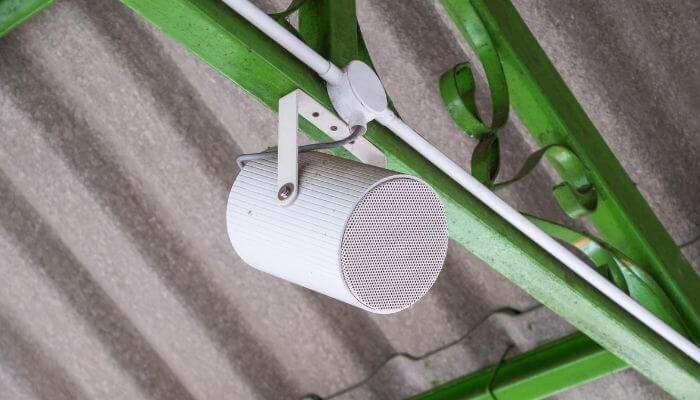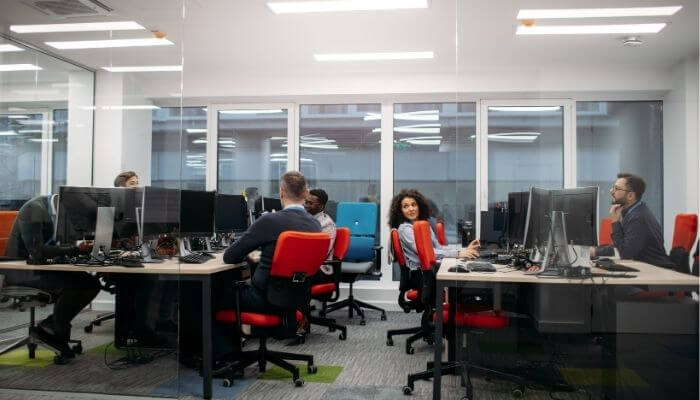Sound Masking is used to make buildings seem quieter.
It works by increasing the volume of ambient background sounds at specific frequencies so that certain sounds, such as conversation, fade into the background thus reducing distractions and creating an environment where conversation can be conducted with more privacy.
The main difference between sound masking and white noise is that sound masking can be done over a very specific frequency range so that it matches the frequency of office chatter, whereas white noise is a mixture of all audible noise frequencies.

How Sound Masking Works
Sound masking is a low-level sound that is tuned in to the same frequencies that humans speak in (usually between 250-6,000Hz).
Sound masking sounds like you have your air conditioning on, the noise is uniform, and is set at a volume level that is barely noticeable.
The sound is typically calibrated to be up to 5dB louder than human speech to help mask the noise.
It is also important that this sound is dispersed evenly throughout a space for it to be effective, so while you could play noise through a pre-existing speaker system to achieve some level of sound masking it is unlikely that you will achieve full uniform coverage through the space.
An effective sound masking setup should use a purpose made speaker system which will ensure that sound is properly dispersed.
A good sound masking system will not be immediately obvious to anyone who enters the room or building, it will just sound like ambient background noise which they won’t notice.
Sound masking is far more technical than white noise.
With white noise you can just play a youtube static noise video, or put on a white noise MP3, however with sound masking you can’t just play a pre recorded sound masking track.
This is because sound masking systems pair their noise generating system with a graphic equaliser, these help to match the acoustics of the room with the generated noise.
How Does It Differ From White Noise?
Sound masking is very similar to white noise as it creates an ambient background noise which causes other sounds to fade into the background.
However, sound masking is far more advanced than white noise because it is designed to mask very specific sound frequencies.
The use cases of white noise and sound masking are also quite different.
White noise has many benefits and is typically used as a sleep aid as it helps all sounds of any frequency blend into the background, however unlike sound masking it is very noticeable and can be distracting.

Sound masking is more commonly used in open-plan office settings where people conversing on the far side of the office can distract people from work.
By using frequencies that are set at a level similar to that of human speech, distracting office conversations become inaudible so you can only hear those close to you.
Example of Sound Masking Products
- A company is known as Cambridge Sound Management sells products to create spaces to record sounds within the room or area. An example of products that they sell is that of the Qt 100. This is used in room spaces and controlled via modules that allow for volume adjustments. The QT 100 is used for single areas covering 12,000 square feet.
- The QT 300 product is used for multi-zone areas that are around 36,000 square spaces.
- Another product used for sound masking is that of Sound Masking speakers. These speakers are used to generate frequencies to create the required dynamic sound range.
Examples of White Noise Products:
- One of the most commonly used white noise products is the Better Sleep White Noise Sound Machine for adults and babies. It allows for the cancellation of outside noise such as traffic or disturbing noises while falling asleep.
- The Dremegg White Noise and Sound Machine has a built-in white noise fan and plays nature sounds of your choice. Additional settings such as a timer with a memory function allow the user to serve its function for specific periods.
- The Sound+Sleep High Fidelity Sleep Sound Machine takes white noise mechanics to a more advanced level. This product derives from the Adaptive Sound Technologies that allows for various sound environments to choose from. It also features the option to avoid an unnecessary loop of sounds to be played.
- Other white noise products can include a whirring fan, television static, and hissing radiators.
As you can see white noise machines are more of a blunt tool which just make the same nosie regardless of their surroundings, whereas sound masking machines are finely tuned and highly engineered to be effective and almost undetectable.
As an Amazon Associate I may earn a small fee from qualifying purchases at no extra cost to you. This helps us run the site, so thanks for your support!